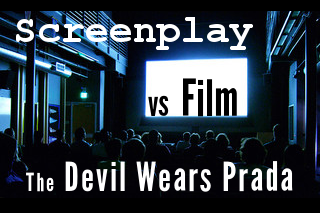Today’s Screenplay vs Film selection is the Devil Wears Prada, the workplace comedy which explores the world of high fashion. It stars Meryl Streep as Miranda Priestly, one of New York’s biggest magazine editors, and Anne Hathaway, as Andy, Miranda’s naive assistant. The movie is adapted from the bestselling book of the same name, which was supposedly based on the author’s experiences working as assistant to Anna Wintour, editor-in-chief of Vogue.
As a very successful adaptation which fared much better at the box office than Something Borrowed and One for the Money, the screenplay is especially good to study for screenwriters working on an adapting a book into a movie.
To compare the movie to a script, I tracked down an old screenplay, originally written by Peter Hedges, with revisions by Howard Michael Gould, Paul Rudnick, and Don Roos…with the most current set of revisions penned by Aline Brosh McKenna (what a cool name!).
The draft I read was pretty good. It was funny, sharp, and structurally solid. If the movie had followed that script exactly, I think the resulting movie would have done well. But the movie didn’t follow this script exactly. A number of changes were made, which greatly improved on the foundation set by the screenplay and turned a strong script a blockbuster.
Unnecessary characters and dialogues were cut from the screenplay; lines were frequently reassigned from one character to another. The end result? The characters in the movie are a lot “tighter” and well-defined than they were in the screenplay. We’re better able to focus on the key players: Andy, Miranda, Nigel and Emily–and the complex power struggles between each. Andy has more of active role in her path to self-destruction. And Miranda–well, the movie made her more of a “devil.”
The majority of changes made to the screenplay were minor and subtle, but are definitely worthy of study. If you apply them to your own screenplay, you should be able to write a script that will get noticed. So onto the screenwriting tips!
Screenwriting Tip #1: Be careful with flashforward beginnings
Flashforwards are a popular screenwriting technique to use at the beginning of movies (and television episodes). For example, the first scene in the script actually comes from the end of the movie, right around the “all is lost” moment or perhaps at the climax.
It’s usually a tense scene which immediately engages the reader…and then we flashback to “how it all began,” rendering the first and second acts one large flashback sequence.
This technique can be successful (it was used at the beginning of Out of Sight, launched the first season of Revenge, and if I’m not mistaken, is how the first Twilight book began), and that’s probably why it was used at the beginning of the Devil Wears Prada screenplay. Here it is:
INT. CHATEAU — FRANCE — DAY
An elegant 17th century mansion a short distance from Paris. A dinner is set for about a hundred people. Everything is perfect; exquisite flowers, linens, silver…
Anyone who’s anyone in the fashion world is there. We see Lagerfeld…Valentino…Marc Jacobs…
NIGEL KIPLING, a dapper man in his late 30s/early 40s, speaks at a podium at the center of the dais on one side of the room.
Our POV is from someone else on the dais so we see NIGEL from the back.
NIGEL
…her name has become legend. Her magazine is the Bible for anyone interested in style, taste and sophistication. Without a doubt one of the most elegant women ever to walk the planet, I give you…Miranda Priestly.
Loud applause rings out. And from the back we see MIRANDA PRIESTLY approaching the podium. We can only make out her fancy updo, the curves of her couture gown.
As MIRANDA lingers, taking in the applause…
We reverse to see whose point of view we are watching from…
…ANDY BARNES, 20s, pretty, elegantly put together. She stands a few feet behind MIRANDA.
She applauds, smiling. Some of MIRANDA’s light spills onto ANDY.
MIRANDA starts to talk and we hear a brief SCREECH of feedback. The SCREECH dissolves into…
FLASH BACK TO:
EXT. MIDTOWN STREET — DAY
…the SCREECH of a taxi, rounding a corner.
Six months earlier. ANDY walks out of a subway station, clutching a piece of paper with a direction on it.
ANDY looks nothing like the polished young woman from the chateau. Her hair and makeup are college student simple.
Andy is looking for the Elias-Clarke headquarters to interview for a position at Runway, which is where the movie version begins. Why did the movie drop the flashforward opening?
The scene at the chateau was well-described…but it didn’t tell us much about the main characters. It didn’t have one hint of conflict. It couldn’t really engage the audience. It’s just a fancy tableau filled with beautiful people.
But seeing an unfashionable girl lost in New York City–that’s a story in one image, a story which can immediately elicit empathy from a large proportion of the target audience.
The flashforward opening can work, especially if the scene you start with is full of conflict, drama and tension and can immediately engage audience sensibilities. But if it can’t, rethink this strategy.
While the Devil Wears Prada couldn’t make use of the flashforward opening, it did get to employ the bookend technique. The movie begins with Andy on the day she interviews at Runway…and it ends on the day she interviews for a position at a reputable New York magazine, encasing the film in “bookends” of interview scenes.
If the flashback opening doesn’t work for your screenplay, try the bookend method. Audiences are fond of bookends as you can see in screenwriting tip #8 from Taken; they bring a nice feeling of closure to movie-goers.
However you choose to begin your screenplay, the best method usually stars the protagonist. After all, it’s HIS story you’re telling.
Screenwriting Tip #2: Fabulous people don’t announce their fabulousness
Fabulous people don’t have to detail their amazing exploits. If they do, it’s usually because they’re insecure or they’re incompetent and are exaggerating their accomplishments to hide their incompetence…which means they’re not so fabulous after all.
Take Gandhi for example. If he went around the streets of Mumbai, with a bullhorn, announcing nonstop, “I have defeated the British. They had an army; all I had was salt!” you’d get irritated with him, even though he was Gandhi.
Now imagine how a reader would feel about YOUR character bragging about his exploits in a massively long speech….when he hasn’t accomplished anything close to what Gandhi did. That’s not going to go over so well.
In the screenplay draft of the Devil Wears Prada that I read, Miranda makes that kind of speech to designer James Holt to show that she singlehandedly can make or break his collection:
JAMES
But obviously, the collection is still a work in progress.
MIRANDA
Actually, no, it isn’t, my love.
[Editorial note: “my love” is not an endearment Miranda would use!]
He looks at her. I beg your pardon?
MIRANDA
You are not going to produce this line. If you do, I will not put any of it in the magazine, nor will you get any department store orders.
JAMES
Miranda, I know the collection is edgy–
MIRANDA
I’m looking through the pieces thinking kimonos, motorcycle jackets, gingham…
(shakes her head)
Most of it, I don’t get at all. What I do get, I don’t like. I cannot let you do this to yourself. Or to me. My reputation is on the line here too.
ANDY watches JAMES. The whole room is pin-drop silent.
MIRANDA
I gave you editorial coverage before anyone else. I made people take notice of you. I was the only editor in the front row of your first show in that warehouse at the pier. In the front row, clapping.
MIRANDA steps closer to JAMES, puts a hand on his shoulder.
MIRANDA
I remember every piece of that first collection. The swing of the chiffon, the vibrance of the embroidery.
She walks over to ANDY and takes the pile of magazines. Throws each on the table in front of JAMES as she talks.
MIRANDA
September 1997, you revolutionize the hemline, March 1998, you bring back femininity out of that horrible monk phase, =June 2000, you’re the first one to do the watercolor florals and February 2002, =you radically rethink the empire waist.
Miranda’s speech has two objectives: to show that she’s good at her job and to show that she made James. Her word can just as easily break him. In other words–she’s a big deal.
But Miranda doesn’t have to tout her own influence. She’s not incompetent or professionally insecure. And she’s not interviewing for a job. So there’s no reason to for her to brag about herself. Others should do it for her.
In the movie version, a lot of these lines were reassigned to Nigel, an assistant editor at Runway magazine. He’s the one who explains to Andy that Miranda’s reaction is the “only one that matters.” When Nigel talks up Miranda’s powerful role in the fashion industry, it adds to her iconic reputation. When Miranda does it, it detracts from it.
If you’re writing a screenplay and one of your major characters is a BIG DEAL, then have other characters explain why and how this is so. There are exceptions of course–if Mr Big Deal is a narcissist or trying to score some professional coup, then let him brag about himself. Just examine who’s establishing how influential and powerful Mr Big Deal is–and why you chose that person to deliver those lines.
Screenwriting Tip #3: Bait actors with sweetness and lines
Do you remember at the beginning of the Devil Wears Prada, Miranda saunters into Runway, the first time we see her, and without pausing for breath, she rattles off a neverending list of instructions to Emily, her first assistant?
Something about not approving Simone’s Brazilian layout, RSVPing for the Michael Kors party, tortes with rhubarb compote, a parent-teacher conference with the ex-husband, making a reservation for her and her current husband at “the place she went to with Massimo,” rejecting photos from the paratrooper editorial, and redoing Gwyneth’s cover shoot.
It was a wonderful introduction to Miranda Priestly. We saw that she was competent, demanding, and moved at a paranormal pace she expected everyone else to follow. She was the boss–and she relished the power it gave her.
In the screenplay draft, those lines belonged to Emily, not Miranda!
25 (!) lines of dialogue–and they weren’t given to Meryl Streep! Unbelievable. It was an incredible waste–not just of the opportunity to show us who Miranda is..but also of Meryl Streep’s screentime.
You might be saying, Aline Brosh McKenna (or any of the other screenwriters who worked on the project) probably didn’t know that Meryl Streep had been cast as Miranda. Maybe not. But Miranda is a star role in the movie–one which could easily attract A-list talent…if she had enough lines.
If you want one of your roles to be actorbait, then make sure that role has the 25-line dialogue! Actors love lines people! (If you want more tips, read How to Write for an A-List Actor by Carson Reeves.)
It’s been said that actors are known for just reading their lines in a screenplay–and nothing else. Let’s imagine you’ve managed to get your script into an A-lister’s hands. He’s reading his lines first, just to check to see if it’s worth his time to read the whole thing, and he notices a twenty-line dialogue in a scene he’s in–but he’s not the one giving the speech.
Houston’s gotta a very large problem–the actor’s ego. Let’s say that despite this blunder, he commits to your script. You can bet that he–or the studio–is going to ask you to rewrite that scene. Do yourself a favor. If you’re trying to write a role as actorbait, then make sure you give the juicy speeches to the actor playing that role. (There are certainly exceptions to this. Please do not sacrifice your story for the sake of actorbait.)
Screenwriting Tip #4: Eliminate unnecessary repetition
In your script, there will be points you want to make, details your audience has to know. Following the screenwriting advice you’ve heard a thousand times, you’ll try to SHOW these things, instead of telling them. That’s great, but make sure you don’t repeat the showing (and if you’re showing AND telling, god help you).
Even talented screenwriters can get lost in the trap of showing/telling details to the audience multiple times, just to make sure we get it. Annie Mumolo and Kristen Wiig did it in Bridesmaids and Aline Brosh McKenna did it in The Devil Wears Prada.
Here’s one example; it concerns a Bang & Olufsen phone:
INT. RUNWAY — DAY
ANDY picks up the phone.
ANDY
Miranda Priestly’s office.
…we pull out to see that while rolling calls, ANDY is also filing things, doing a spreadsheet and unwrapping presents.
She covers the receiver, holds up a box to show EMILY.
ANDY
Charlie Rose gave Miranda a phone for her birthday.
She holds up an expensive, fancy Bang & Olufsen phone.
EMILY
A phone. How tacky. Get rid of it before she sees it.
ANDY
How do I do that?
INT. MCSORLEY’S — NIGHT
ANDY joins her friends and NATE. ANDY plops the phone on the table.
But everyone barely looks at the phone. They’re all preoccupied by her appearance.
NATE
Wow.
ANDY
I know. Awesome phone, right? Bang & Olufsen. Emily said I could keep it.
Boom!
The previous 16-line scene in the the Runway office becomes completely unnecessary. Odds are, your current screenplay draft is rife with similar repetitions. Pick the best way of showing, and move on. Save your valuable screenplay pages to develop your subplots and flesh out your theme.
Screenwriting Tip #5: Eliminate unnecessary characters
Some characters in your script will just appear in a one scene, and that’s it. For example, your leading ladies can get lost while driving and ask for directions from an insolent teenager, who never appears again in your screenplay. That’s fine. Without getting directions from the teenager, who steers them down the wrong road, those leading ladies would never end up embroiled in crazy hijinks in Missoula.
What you want to watch out for are characters who have one scene, never reappear in the screenplay, are usually bestowed with a name even though they only have one scene…but whose lines could easily be said (or their point made) by another character with a much bigger role in the screenplay.
Get rid of the person who only appears in one scene and transfer their lines to someone else. It’s kind of like the Bible philosophy in Luke 19:26, “to those who use well what they are given, even more is added to them.”
This advice probably doesn’t make much sense without examples, so here are two from the Devil Wears Prada.
Here’s a scene involving a girl named Lisa:
Suddenly, EMILY sees a tall, gorgeous African-American woman.
EMILY
What are you doing here, you witch?!
LISA
I just popped over to hi to Nigel.
EMILY and LISA hug. EMILY turns to ANDY.
EMILY
This is Lisa, I’m the old her. Miranda loves her and got her another totally FAB job.
ANDY looks at LISA, curious.
LISA
It’s not a big deal.
(feigning nonchalance)
Assistant editor at the New Yorker.
ANDY
The New Yorker? You’re kidding me.
EMILY
Yeah. She’s a huge kidder. Especially with people she doesn’t know or care about.
Lisa’s scene makes an important point–if Andy survives a year with Miranda, she can get the kind of journalism job she wants. So when Miranda torments Andy, we’ll know why she sticks around. But that point’s been made–Emily’s mentioned it, Andy’s mentioned it, and we get it.
But even if Emily and Andy hadn’t mentioned it, there’s no need to have Lisa make this point. She never appears in the screenplay again–so why use her at all?
Here’s my second example, this one involving an accessories editor named Jocelyn:
INT. ELIAS-CLARKE LOBBY – DAY
JOCELYN, the accessories editor, waits for the elevator. ANDY, winded, carrying the tower of scarf boxes, races over.
ANDY
(pleased with herself)
I made it back in time.
(off JOCELYN’S look)
You don’t care do, do you?
JOCELYN
Miranda does have an eye for the sharp girls.
ANDY
(re: scarf boxes)
She must really like these things.
JOCELYN
They’re her signature, the Hermes white scarf. She’s never seen without them and she goes through them like Kleenex.
ANDY
Oh.
(beat)
You know if by chance you ever need any writing done, I was editor of my college newspaper–
JOCELYN looks at her.
ANDY
And there’s that thing again where you don’t care.
They hear the ding of the elevator and walk in. But suddenly JOCELYN sees MIRANDA walking toward the elevator. She immediately gets out.
MIRANDA stands by the elevator, looking at ANDY.
ANDY stays, looking confused. MIRANDA waits.
Finally, JOCELYN walks in and pulls ANDY out. MIRANDA gets in the elevator alone. After the doors close–
ANDY
We can’t ride up with her? Why?
JOCELYN
Half a day on the job and you’re still asking “why?” That concerns me.
I actually like the elevator bit and wish the scene was still in the movie–minus Jocelyn. She never appears again in the entire script. Jocelyn can go.
With minor modifications, Jocelyn’s lines could easily be transferred to either Nigel or Emily, supporting characters who appear in multiple scenes, who play key roles in Andy’s story, and in whom we’ve become invested. Plus, by giving ancillary characters more lines…you guessed it…you can turn supporting roles into actorbait too, attracting attract great talent like Emily Blunt and Stanley Tucci.
Screenwriting Tip #6: Remember, there’s a trailer!
For the most part, audiences know a bit about a movie’s plot before they go to see it. If they’re going to the movie theater, they’ve seen a trailer on TV or online. If they’re renting the movie, they’ve read a brief description on the back on the DVD case or online. Either way, the hook of the movie is revealed in the trailer and in the product descriptions…well…to hook a prospective purchaser. Makes complete sense.
This means though that one of your key plot points will be well known to your audience. So don’t belabor that point in your script, especially if your screenplay is already running too long. In the Devil Wears Prada screenplay draft I read, Andy leaves her interview to drown her sorrows with her friends and still doesn’t know if she got the job at Runway:
INT. MCSORLEY’S — NIGHT
A dark, loud bustling bar, one of those McSomething bars you spend your twenties in.
ANDY is with her boyfriend NATE, a friendly, handsome guy with a great smile, and their friends from college, DOUG and LILY.
ANDY is in a full-body cringe.
ANDY
I basically came out and told her I had no idea that she’s one of the most important people in New York publishing. Oh, and then I rambled like a crazy person.
LILY
When do you find out if you got it?
ANDY
Have you not heard what I’ve been saying? I was a jackass. I’m not getting it.
DOUG
You never know. Miranda Priestly is famous for being unpredictable.
ANDY
On my God. How is it that you know who she is and I didn’t?
DOUG
I’m actually a girl.
LILY
That would explain so much.
(This part is followed by Andy voicing her fear that she just blew her best shot at getting her break into journalism, but I didn’t feel like typing those lines. I think you got the point.)
The thing is…we know that Andy definitely gets the job. If she didn’t, there wouldn’t be a movie. As a matter of fact, watching her try to survive this job is the hook that reeled a number of movie-goers in the first place. In the movie, Andy still meets with her friends after her interview, but this time, she knows she has the job. Instead of wasting screenplay real estate expressing her doubts and apprehension, we see her toast to “jobs which pay the rent.” Much better.
Final thoughts
Tomorrow, I’ll post more screenplay writing tips I learned from comparing the Devil Wears Prada script to its movie version, including how to handle celebrity cameos!
If you’re thinking that the scenes you’re writing now pale in comparison to the ones that got eliminated from the final cut of the Devil Wears Prada…or aren’t anywhere close…don’t worry. You’ll get better with practice!
Watching a blank screen (with modifications) by Kenneth Lu




















